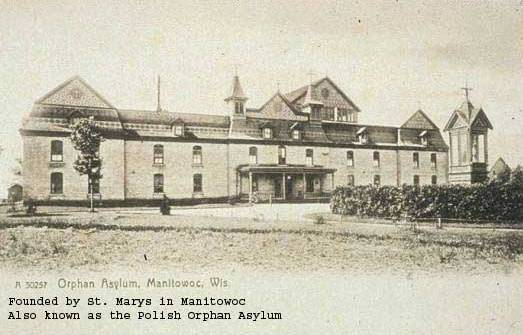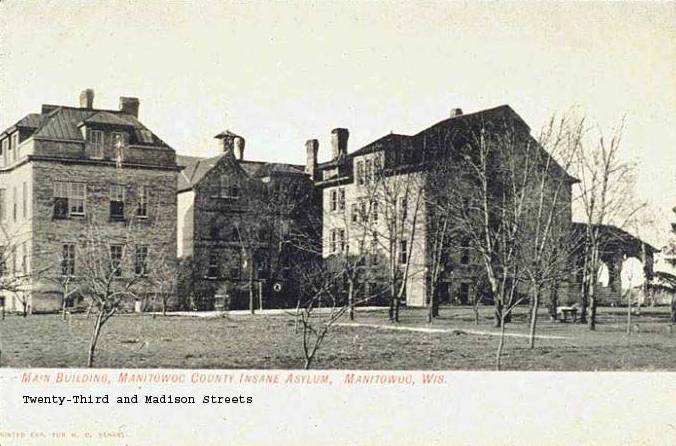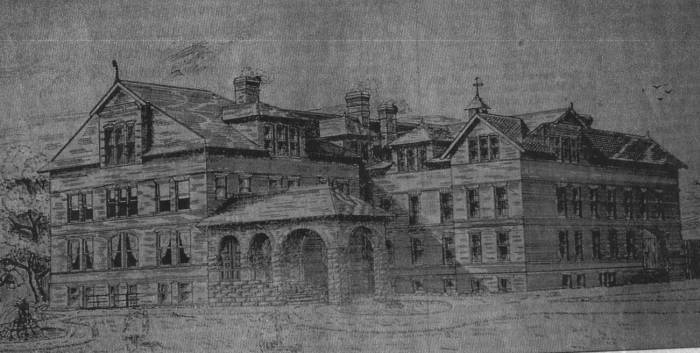
Manitowoc County Homes for the Less Fortunate







The Manitowoc County Hospital
Means of Providing for the UnfortunateFrom "History of Manitowoc County"by Falge, pg. 43 It was the custom, under the law, in the primitive days of the county, for each town to make provision for the care and sustenance of those of its people who were in indigent circumstances. In March, 1851, this system was abolished and, what was termed the county system, established. To comply with the law the board of supervisors elected three superintendents of the poor and in the following May a quarter section of land was purchased in the town of Manitowoc Rapids, near the then county seat, and suitable buildings were erected thereon for the tenancy of all citizens of the county becoming a public charge. This institution was given the title of the County Poor Farm and was so designated until it was abandoned for the purposes originally designed, the county having reverted to its first method, by which the individual towns were made responsible for their own helpless ones, and this system obtains today. Recently strenuous efforts have been made by both men and women of the county, seeking better and permanent means of providing for and taking care of those having a claim on the county's bounty. The matter took substantial form, in that meetings were held and plans formed by a committee, for the establishing of an institution by the county, erecting and furnishing buildings therefore, which should be called the County Home. The project was made abortive, however, by unanticipated opposition, but the friends of the project are not discouraged by defeat and still have strong hopes that their philanthropic innovation will soon take concrete form and become a reality, indeed.

The Manitowoc County Asylum This is a drawing of the asylum in 1885 that I ran across. I forgot to make a note as to where I found it.
The county asylum was not actually an insane asylum, but rather a facility to assist in the aid of those with T.B.(tuberculosis), physical health ailments, or mental health ailments.
From "History of Manitowoc County" To William Rahr is due more credit, probably than any other man in the county, for the provision of an asylum for the care of the chronic insane of Manitowoc county. On April 18, 1884, he introduced a resolution in the county board, providing for a committee to investigate the expense of maintaining the insane of the county and the probable cost of building an asylum. Following favorable action on this resolution the necessary steps were taken and an asylum was built during the following summer. Mr. Rahr served on the first committee of investigation, later on the building committee and was the first trustee elected to the asylum board. The first board of trustees was composed of Messrs. William Rahr, John Carey, Henry Vits, Henry Goedjen and C. F. Hacker. Consequent to the resignation of William Rahr, William Lueps was appointed in his stead. On March 26, 1884, Gustav Mueller, of Reedsville, was elected as the first superintendent of the Manitowoc county asylum. On January 17, 1885, the first patients were brought to the asylum and up to May 23rd of the same year, when the first report was made, fifty-seven patients had been given care and comfort in the asylum. Previous to that time they had been confined in the county jail, while some had been left in charge of a keeper at St. Nazianz. In the next ten years the number of patients had increased to one hundred and thirty-four and at various times it had become necessary to make additions to the asylum. At this time William Rahr was again elected trustee and the next year, following the resignation of Gustav Mueller and wife, Henry Goedjen and his wife were elected as superintendent and matron. By this time the buildings and equipment had become entirely inadequate for the purpose. So, in the summer of 1897, complete changes were made. Parts of various buildings were remodeled, additional land was purchased, and sanitary conditions improved so that the institution was modernized in equipment and ranks with the best of its kind in the state. As a result of these changes the number of outside patients increased from sixty-three to one hundred and six within the next two years. In 1902 William Rahr again severed connections with the institution and Henry Wernecke was elected his successor. Much credit is due Mr. Wernecke in conjunction with Mr. Goedjen, the superintendent. To these two, through skillful management and far-sightedness, is due, in a large measure, the prosperity of the last few years of the asylum. It was a distinct loss to the county when Mr. Goedjen died, October 5, 1911. He was succeeded by Roland Kolb, former farm Manager. Mrs. Goedjen was retained as matron. It has been repeatedly said by all in a position to know, that, while other institutions may be ahead of Manitowoc county in the number and cost of its buildings, nowhere in the state are patients better cared for or given more homelike surroundings. This is due to the efforts of the matron, Mrs. Goedjen. The trustees are Louis Wiegand, William Kiel, and Henry Wernecke. The original farm property of the asylum comprised fifty-seven acres. Now the acreage has been increased to two hundred and sixty-five acres. Owing to the fact that the land was purchased from time to time, some of it is about two miles from the institution. The original building was first intended to house abut seventy-five patients, for whose care and support the county is paid by those responsible , and with the revenue derived from the farm the running expenses of the asylum has been self-sustaining for a number of years.
From "History of Manitowoc County"
A GOOD REPORT. Made by Trustees of County Insane Asylum. The thirteenth annual report of the board of trustees of the Manitowoc County Insane Asylum contains some interesting data which readers of the Hereald will appreciate. Heretofore it has been customary for the trustees alone to make a report but the law says the superintendent of the institution shall also make a report, and the following facts are in accordance with the two reports: The total expected receipts from all sources are $28,609.81 and the expenditures for the care of the patients was $14,919.70 leaving a net gain of $9,690.20 for the county. The superintendent reports 8593 weeks of board furnished, bringing the per. capita cost per week to $1.62. The per capita cost for the year 1897 was $1.41, showing an increase of 21c. a week. The improvements made are mentioned at some length. Among the most useful was the sewer ordered by the board at their last session and which is now complete at a cost of $2753.80. The farm buildings, which were started last spring, have been finished and it is the opinion of the board that no more building will be necessary for some years to come. In the report special mention is made of the sale of the six acres of the Wood farm, sold to the C. & N.W. R'y Co., setting forth the advantages derived from the deal. The property has increased in value and at present is slated at $136,266.87. The health of the patients has been exceptionally good, but four deaths being reported for the year. From a sanitary point of view the county has a model institution for the care and keeping of chronic insane. Dr. Luhman, the attending physician, recommends the erection of a large enclosure for the use of patients who are unable to get exercise. Taken as a whole the report is a very creditable one and much praise is due those in charge. Manitowoc Daily Herald, Manitowoc, Wis. Thursday, November 17, 1898 P. 1
Paupers in the house 39; Paupers left the house, 32; No. remaining. 7 Days board of the 39 paupers--3502. The clearing is 24 Acres. CHESTER BUEL, CHAS. KLINGHOLTZ, Commissioners. Manitowoc, Nov. 22d, 1854. Manitowoc Tribune, Manitowoc, Wis. Saturday, November 25, 1854 P. 3
Cemetery Burials
|